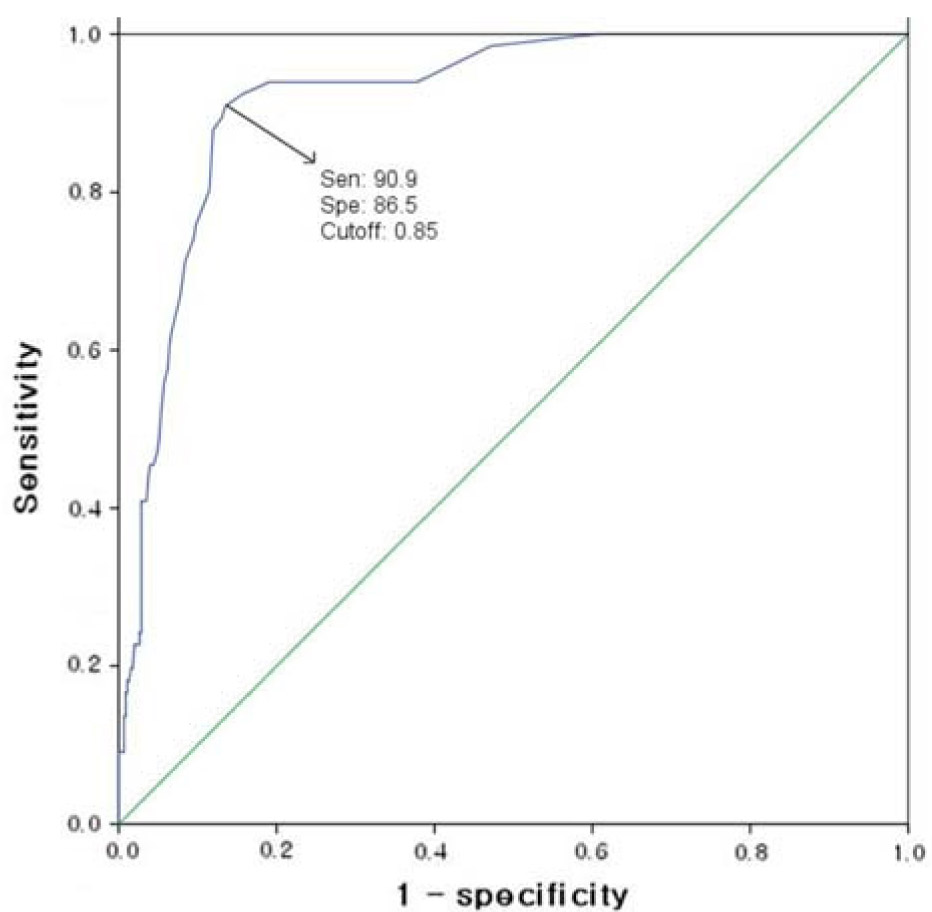Infect Chemother.
2009 Jun;41(3):154-159. 10.3947/ic.2009.41.3.154.
Practical Application of Quantitative HiSens Auto Rapid Plasma Reagin Latex Turbidimetric Immunoagglutination for Diagnosing Syphilis; Comparison Analysis between Rapid Plasma Reagin Latex Turbidimetric Immunoagglutination Test and Rapid Plasma Reagin Card Test
- Affiliations
-
- 1Department of Laboratory Medicine, Kosin University College of Medicine, Busan, Korea. terminom@hanmail.net
- KMID: 1782317
- DOI: http://doi.org/10.3947/ic.2009.41.3.154
Abstract
-
BACKGROUND: The purpose of this study was to evaluate validity of quantitative RPR LTIA, HiSens Auto RPR LTIA (HBi Corp., South Korea) and to decide an adequate cutoff value for syphilis screening.
MATERIALS AND METHODS
A total of 549 serums or plasma specimens from patients were tested with RPR LTIA and RPR card tests. Degree of agreement between the two methods was analyzed, and validity of RPR LTIA test was analyzed by receiver operating characteristic (ROC) curves. Sensitivity, specificity, positive predictive value (PPV), negative predictive value (NPV), accuracy, and ROC statistics of the RPR LTIA test were analyzed to decide an adequate cutoff value.
RESULTS
Agreement analysis showed slight to moderate agreement (k=0.093-0.588, P=0.000). Kappa value had its highest value at the cutoff value of 1.3 and 1.6 (k=0.588, P=0.000). Kappa value at the cutoff value of 1 ranked second (k=0.578. P=0.000). A plot of ROC curve showed a statistically valid result to differentiate between a syphilis test positive group and a syphilis test negative group (AUC=0.92, P=0.000). The cutoff values in RPR LTIA test ranged between 0.65 and 1.15 when both sensitivity and specificity were higher than 80%.
CONCLUSION
HiSens Auto RPR LTIA test showed statistically valid result to differentiate between syphilis test groups. Considering the importance of sensitivity in screening for syphilis and the degree of agreement with RPR card test, the cutoff value of 1 in HiSens Auto RPR LTIA test is thought to be adequate.
Keyword
MeSH Terms
Figure
Reference
-
1. Müller I, Brade V, Hagedorn HJ, Straube E, Schörner C, Frosch M, Hlobil H, Stanek G, Hunfeld KP. Is serological testing a reliable tool in laboratory diagnosis of syphilis? Meta-analysis of eight external quality control surveys performed by the german infection serology proficiency testing program. J Clin Microbiol. 2006. 44:1335–1341.
Article2. Perryman MW, Larsen SA, Hambie EA, Pettit DE, Mullally RL, Whittington W. Evaluation of a new rapid plasma reagin card test as a screening test for syphilis. J Clin Microbiol. 1982. 16:286–290.
Article3. Lynn WA, Lightman S. Syphilis and HIV: a dangerous combination. Lancet Infect Dis. 2004. 4:456–466.
Article4. Hook EW 3rd, Marra CM. Acquired syphilis in adults. N Engl J Med. 1992. 326:1060–1069.
Article5. Larsen SA, Steiner BM, Rudolph AH. Laboratory diagnosis and interpretation of tests for syphilis. Clin Microbiol Rev. 1995. 8:1–21.
Article6. ICDDRB. Estimated deaths due to rotavirus in Bangladesh. Health Sci Bull. 2006. 4:6–10.7. Ansari-Lari M. Comparison between two tests results, kappa statistic instead of simple overall agreement. Vet Parasitol. 2005. 133:369–370.
Article8. Landis JR, Koch GG. The measurement of observer agreement for categorical data. Biometrics. 1977. 33:159–174.
Article9. Zweig MH, Campbell G. Receiver-operating characteristic (ROC) plots: A fundamental evaluation tool in clinical medicine. Clin Chem. 1993. 39:561–577.
Article10. Hanley JA, McNeil BJ. The meaning and use of area under a receiver operating characteristic (ROC) curve. Radiology. 1982. 143:29–36.
Article11. Grimes DA, Schulz KF. Uses and abuses of screening tests. Lancet. 2002. 359:881–884.
Article12. Geusau A, Kittler H, Hein U, Dangl-Erlach E, Stingl G, Tschachler E. Biological false positive tests comprise a high proportion of Venereal Disease Research Laboratory reactions in an analysis of 300,000 sera. Int J STD AIDS. 2005. 16:722–726.
Article13. Garner MF, Backhouse JL. Chronic biological false-positive reactions to serological tests for syphilis in blood donors. J Clin Path. 1970. 23:478–480.
Article14. Garner MF. The biological false positive reaction to serological tests for syphilis. J Clin Pathol. 1970. 23:31–34.
Article15. Peter CR, Thompson MA, Wilson DL. False-positive reactions in the rapid plasma reagin-card, fluorescent treponemal antibody-absorbed, and hemagglutination treponemal syphilis serology tests. J Clin Microbiol. 1979. 9:369–372.
Article16. Lee KW, Lee CJ, Chang CY. Statistical analysis of serologic test for syphilis during five years. Korean J Dermatol. 1979. 17:441–450.17. Noh J, Ko HH, Yun Y, Choi YS, Lee SG, Shin S, Han KS, Song EY. Evaluation of performance and false positivity of mediace RPR test that uses a chemistry autoanalyzer. Korean J Lab Med. 2008. 28:312–318.
Article
- Full Text Links
- Actions
-
Cited
- CITED
-
- Close
- Share
- Similar articles
-
- Evaluation of AutoLab Rapid Plasma Reagin and AutoLab Treponema pallidum Latex Agglutination for Syphilis Infection Testing
- Comparison of Quantitative Results among Two Automated Rapid Plasma Reagin (RPR) Assays and a Manual RPR Test
- Comparison of the Results among Automated Treponema pallidum Latex Agglutination, Rapid Plasma Regain and Treponema pallidum Particle Agglutination, Rapid Plasma Regain Card Test in Blood Donors
- Comparative Performance of the Reverse Algorithm Using Architect Syphilis TP Versus the Traditional Algorithm Using Rapid Plasma Reagin in Florida's Public Health Testing Population
- Analysis of Positive Results in Mediace Rapid Plasma Reagin and Treponema pallidum Latex Agglutination as the Automated Syphilis Test



